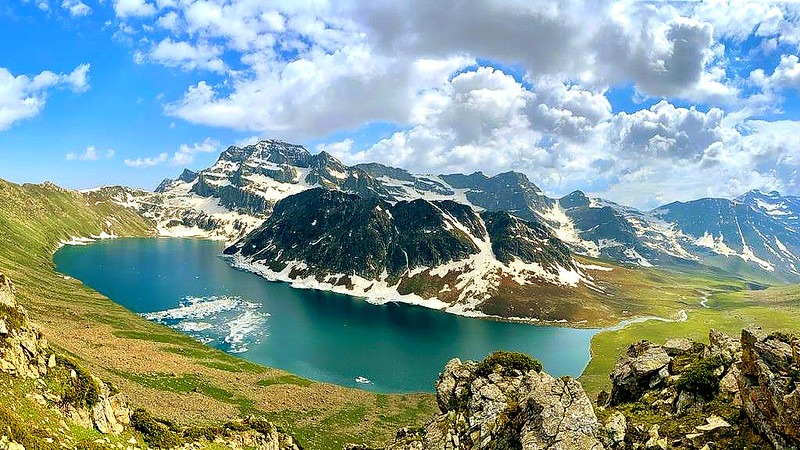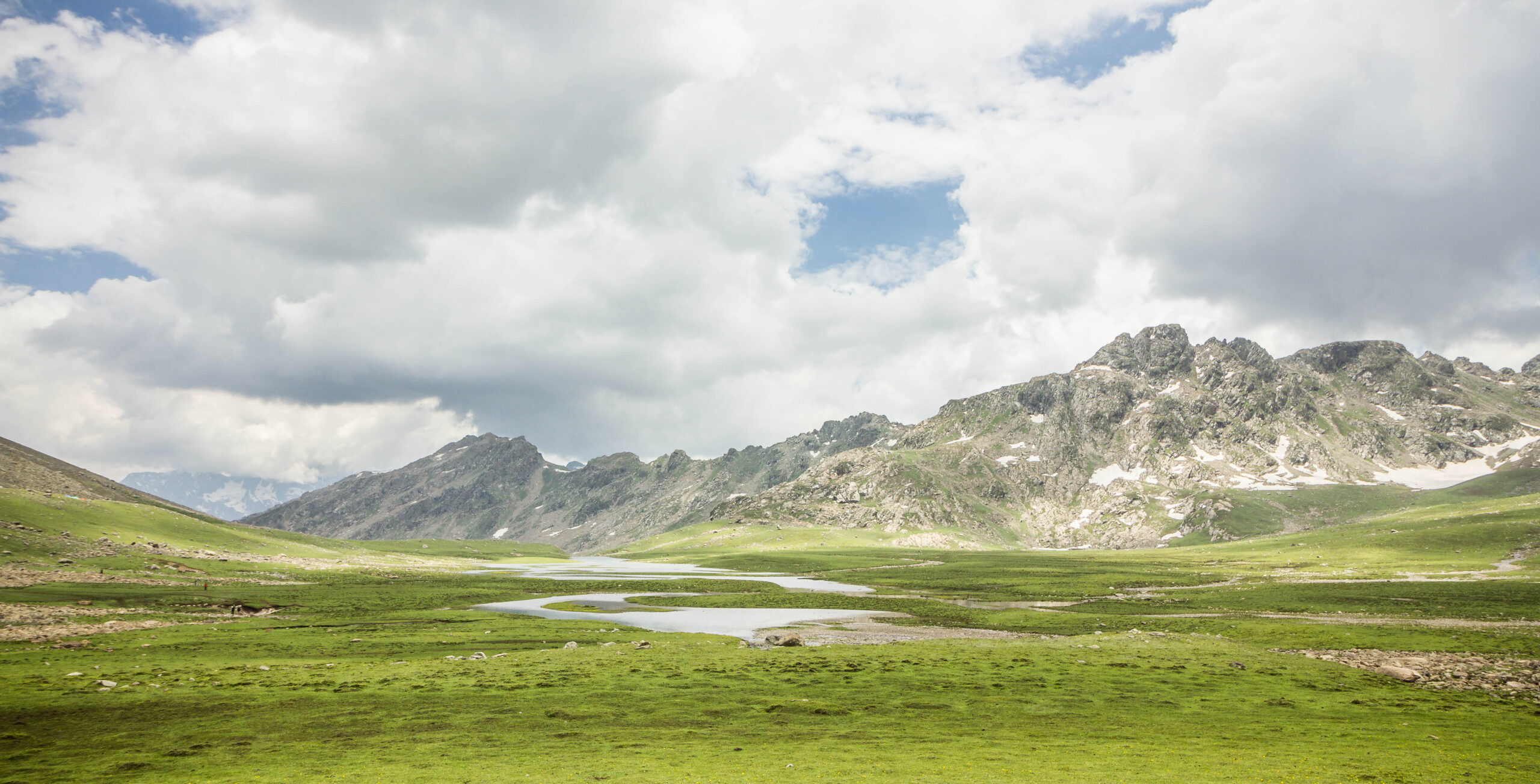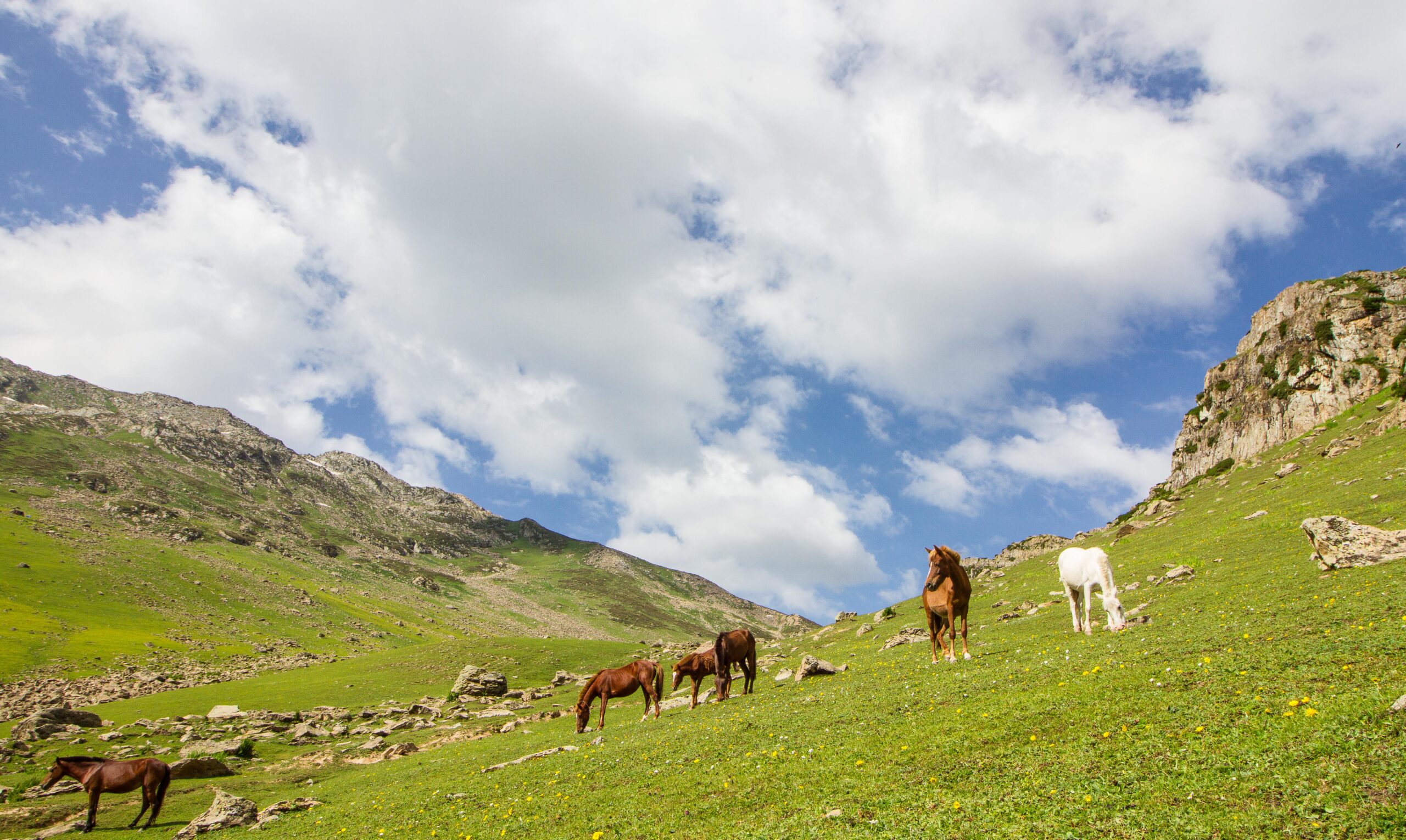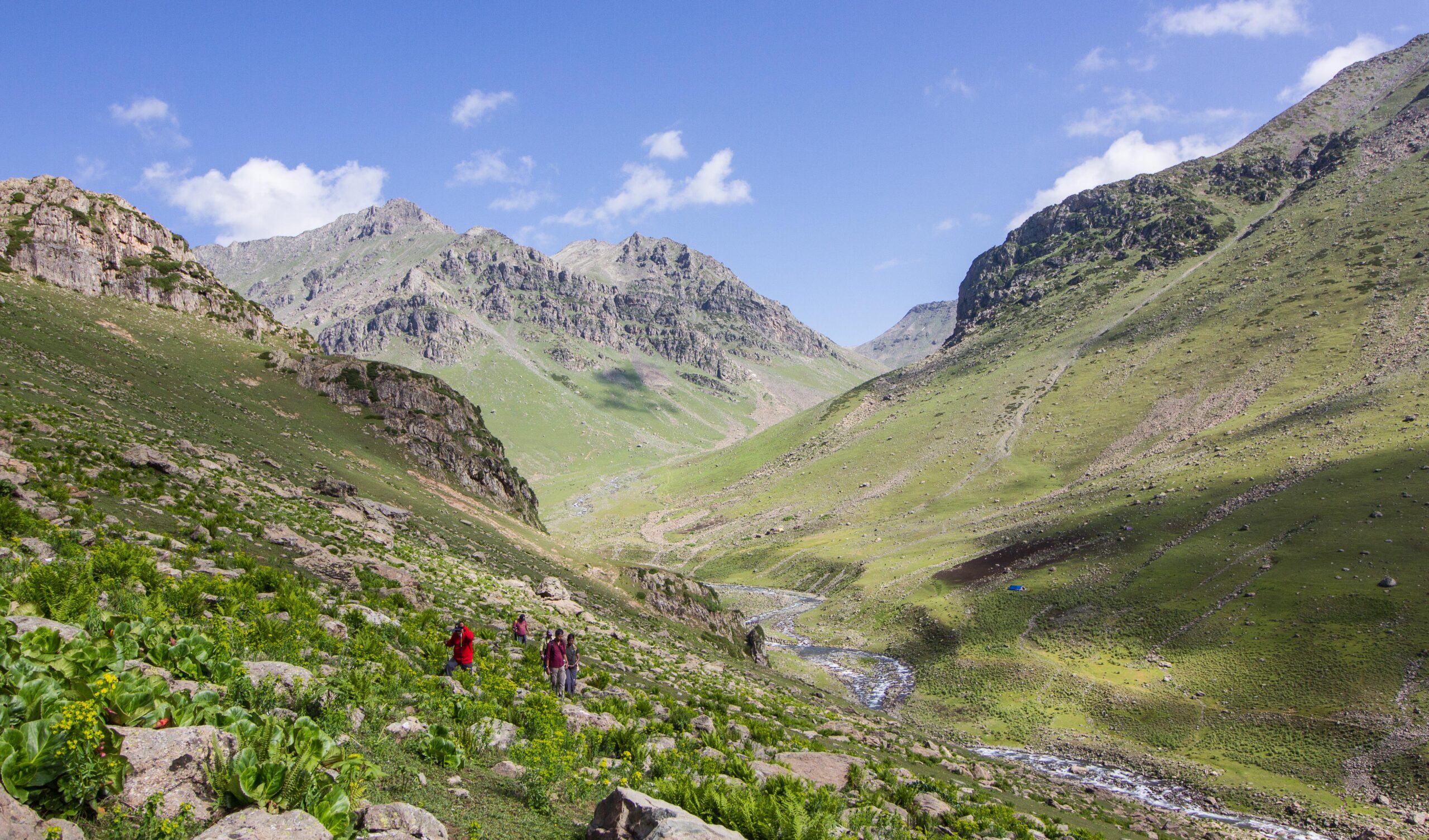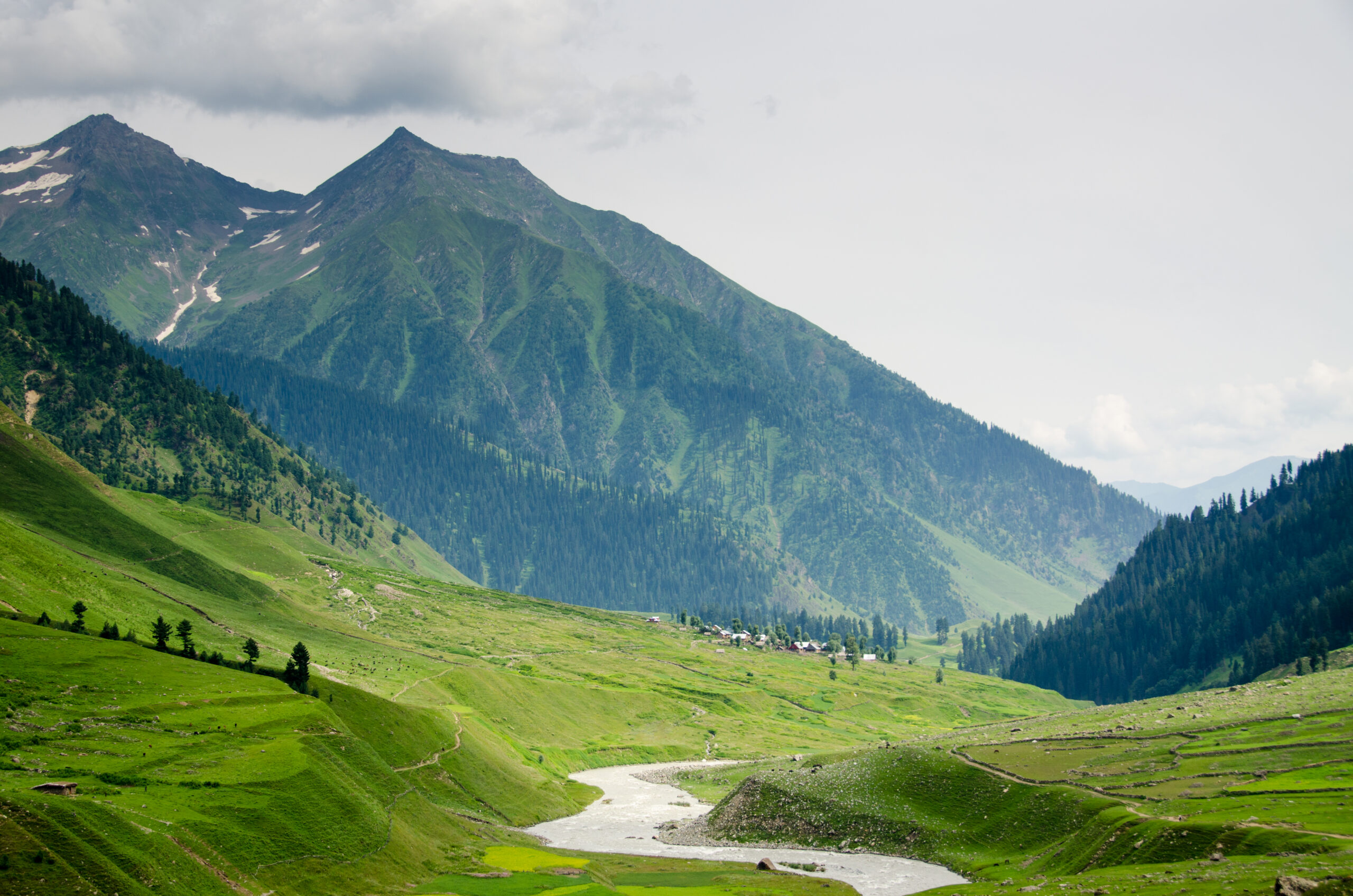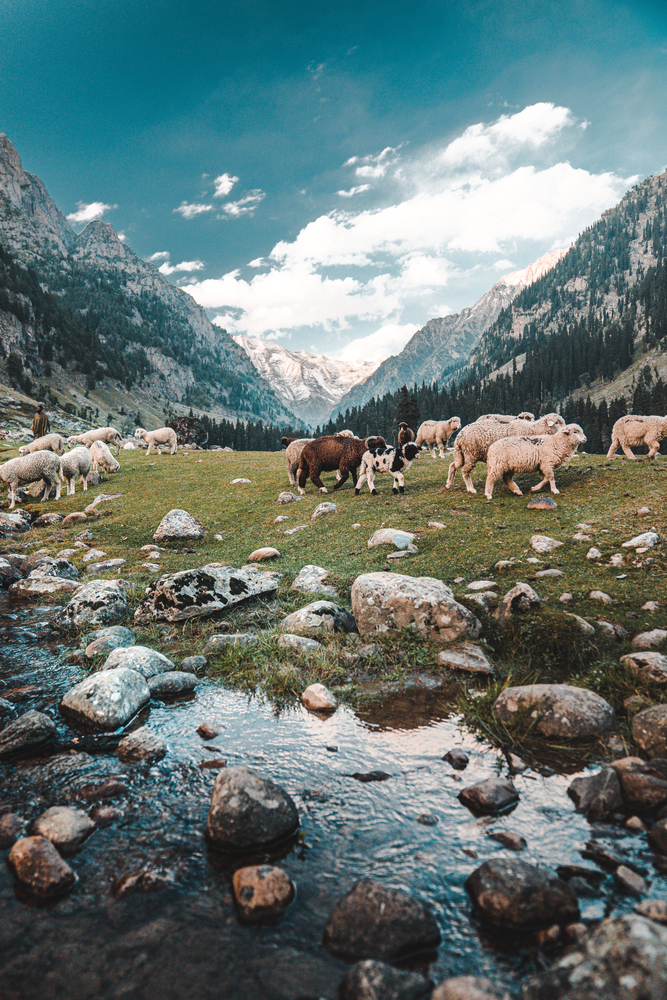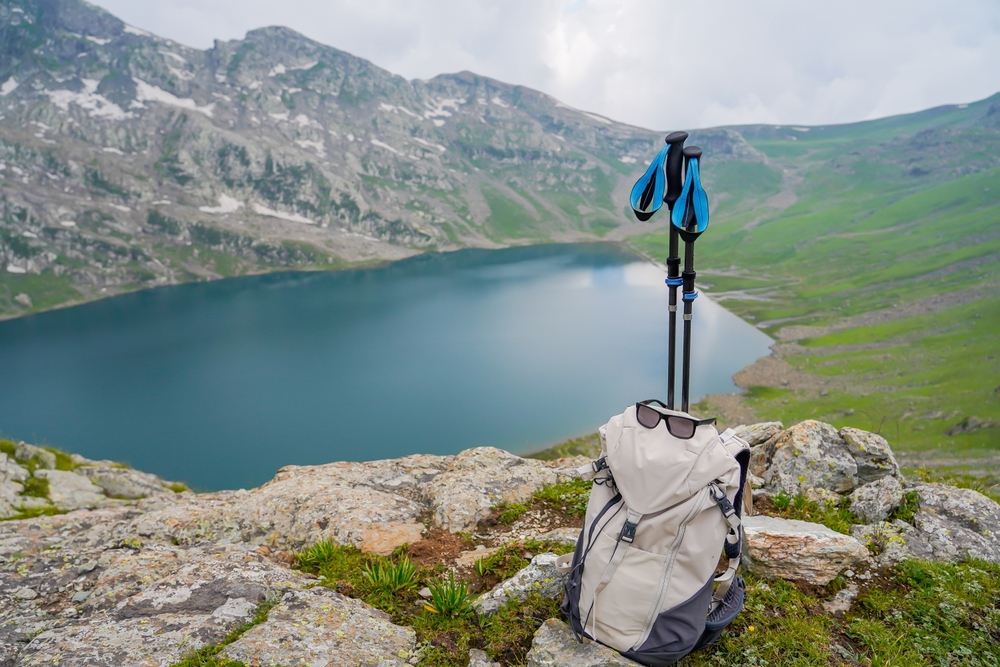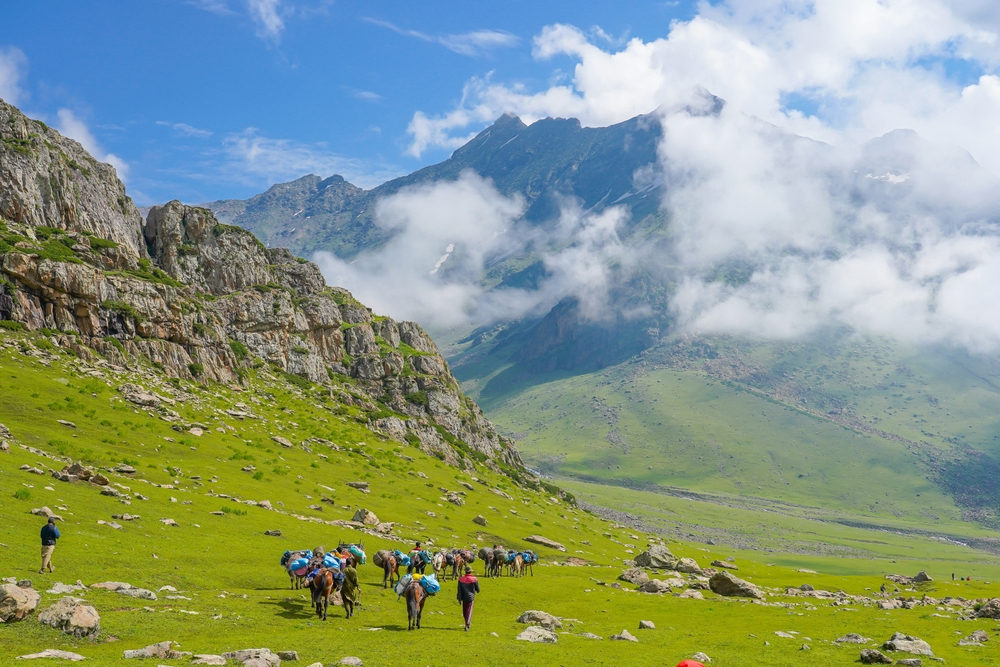Tarsar Marsar Trek
Trek Grade
Moderate-Difficult
Top Altitude
13,500 ft.
Base Camp
Aru Valley
Trek Duration
7- Days
Overview
Have you ever dreamt of walking through a land untouched by the chaos of the modern world, where nature seems to whisper its ancient secrets? The Tarsar Marsar Trek in Kashmir is that dream brought to life. This trek isn’t just a walk in the mountains, it’s an immersive experience into the serene beauty of alpine meadows, crystal-clear lakes, and snow-capped peaks. If you’re a nature lover, a trekking enthusiast, or someone seeking tranquility away from the hustle of everyday life, this trek is the ultimate escape.
The Tarsar Marsar Trek is known for its untouched wilderness. As you walk through lush green meadows, you’ll find yourself surrounded by wildflowers, grazing sheep, and the distant sound of the wind rustling through the trees. The trek is a moderate to difficult challenge, making it ideal for trekkers with some experience. But don’t worry, every drop of sweat is worth it. The reward is spectacular views of the twin alpine lakes, Tarsar and Marsar, which glisten like jewels nestled in the mountains.
[expander_maker id=”1″ more=”Read more” less=”Read less”] Along the way, you’ll pass through charming campsites where you’ll pitch your tent and fall asleep under a blanket of stars. As you wake up each morning, you’ll be greeted by views of the towering peaks and the tranquil lakes, reflecting the beauty of the ever-changing sky. It’s the kind of place that recharges your soul, making every step you take feel like a part of something much bigger.[/expander_maker]
Available Dates
July 2024
| Date | Status |
|---|---|
| 22 June 2024 | Open |
| 23 June 2024 | Open |
| 29 June 2024 | Open |
| 30 June 2024 | Open |
| 06 July 2024 | Open |
| 07 July 2024 | Open |
| 08 July 2024 | Full |
August 2024
| Date | Status |
|---|---|
| 22 June 2024 | Open |
| 23 June 2024 | Open |
| 29 June 2024 | Open |
| 30 June 2024 | Open |
| 06 July 2024 | Open |
| 07 July 2024 | Open |
| 08 July 2024 | Full |
Inclusions & Exclusions
Tarsar Marsar Trek Highlights
- Alpine Lakes: Tarsar and Marsar are two stunning high-altitude lakes, offering mesmerizing reflections of surrounding mountains and ever-changing skies.
- Diverse Wildlife: Keep an eye out for mountain goats, snow leopards, and a variety of birds, including the Himalayan Monal.
- Majestic Views: Enjoy panoramic views of the snow-capped peaks of the Himalayas, including the beautiful Kolahoi Peak, the highest in Kashmir.
- Rich Flora: The trek is blessed with an abundance of flora, from vibrant wildflowers to alpine shrubs, offering a feast for nature lovers.
- Cultural Experience: Interact with local shepherds and experience the traditional Kashmiri lifestyle, complete with their warmth and hospitality.
- Starry Nights: Camp under the stars with no light pollution, offering some of the clearest night skies you’ll ever witness.
Tarsar Marsar Trek - Complete Information
Tarsar Marsar Trek is truly a journey of a lifetime, but there’s so much more to explore and discover. From the best time to visit and essential trekking tips to detailed itineraries and packing lists, we’ve got you covered. Whether you’re a first-time trekker or a seasoned adventurer, this guide will provide you with all the information you need to make your trek as smooth and enjoyable as possible. So, keep reading and let’s dive deeper into this adventure!
Tarsar Marsar Trek Itinerary
Day 1: Srinagar to Aru
- Altitude: 7,950 ft. (2400 m)
- Altitude Gain: 2720 ft. (829 m)
- Drive Distance: 112 km.
- Drive Time: 3-4 hrs.
The adventure kicks off with a scenic drive from Srinagar to Aru, covering a distance of about 100 km. The journey takes around 3 to 4 hours, depending on the route you choose. The drive takes you through the NH1 Highway, and as you approach Pahalgam, you’ll be treated to views of the Lidder River, which flows through the valley. From Pahalgam, it’s just a 12 km drive to Aru, a small village nestled at the foot of the majestic mountains.
There are two main routes to reach Aru from Pahalgam. One route goes through Anantnag, but the more picturesque option is through Bijbehra. If you take the Bijbehra route, you’ll be treated to stunning views of rural Kashmir. Along the way, you’ll pass lush apple orchards, apricot groves, and walnut trees, giving you a glimpse of the region’s natural beauty.
[expander_maker id=”1″ more=”Read more” less=”Read less”] Once you arrive in Aru, you’ll find your campsite ready to welcome you. You’ll arrive in Aru around 1 pm, giving you enough time to settle into your riverside camp before dusk. The drive is not only about reaching your destination but about immersing yourself in the spectacular landscapes that Kashmir has to offer.
[/expander_maker]
Day2: Aru-Lidderwat
- Altitude Gain: 7,960 ft to 9,120 ft
- Trek Distance: 10 km.
- Time Taken: 5-6 hrs.
- Trek Grade: Easy-Moderate
After a peaceful night in the serene Aru Valley, it’s time to lace up your trekking boots and begin the journey toward Lidderwat, one of the most breathtaking spots in Kashmir. You start the day with a hearty breakfast at the campsite, giving you the energy to tackle the trek ahead.
The trek to Lidderwat is approximately 11 kilometers and will take around 5 to 6 hours. The path begins gently, meandering through lush green fields and pine forests, giving you plenty of opportunities to pause and admire the beauty around you. The trek is not overly difficult, but it is steadily uphill, allowing you to gradually soak in the grandeur of the landscape.
[expander_maker id=”1″ more=”Read more” less=”Read less”] As you move forward, the trail follows the course of the Lidder River, which flows beside you, its crystal-clear waters shimmering under the sunlight. The sound of the river is soothing, almost like a melody that keeps you company throughout the hike. The riverbanks are adorned with wildflowers and tall grasses, adding to the natural charm of the area.
The trail to Lidderwat offers a chance to truly escape into nature. With every step, you feel further removed from the noise and stress of the modern world. The smell of pine trees fills the air, and the distant mountain peaks seem to beckon you forward. It’s a peaceful walk, with nature as your constant companion, offering moments of stillness and reflection.
As you get closer to Lidderwat, the landscape begins to open up, and the towering peaks grow taller and more imposing. The sight of the majestic mountains against the expansive green landscape is awe-inspiring. It feels as though the whole world has opened up in front of you, and you are a small part of a much larger picture. This is the kind of beauty that makes trekking worthwhile.
Upon arriving at Lidderwat, you’ll find your camp set up against the backdrop of these grand mountains. The area is vast and surrounded by nature’s untouched beauty, offering a perfect place to rest and relax after a day of trekking. As you settle into camp, you can’t help but feel a sense of accomplishment and peace. The quiet of the place is overwhelming, broken only by the sound of the wind in the trees and the occasional bird call.
Later in the evening, you’ll gather around the campfire for a delicious dinner, cooked by your trekking crew. The warmth of the fire and the crisp mountain air create the perfect environment to unwind after a day of exploration. As the sun sets and the stars start to appear in the sky, you’ll find yourself marveling at the beauty of the night, far from the lights and noise of the city.
At Lidderwat, the day ends with a sense of tranquility and awe. The surrounding landscape, the majestic mountains, and the endless sky create a magical atmosphere that feels like it’s all yours. This is the kind of place that makes you feel completely in tune with nature, giving you a sense of calm and connection that is hard to find anywhere else.
[/expander_maker]
Day 3: Lidderwat – Shekwas
- Altitude Gain: 9,120 ft to 11,035 ft
- Trek Distance: 6 km.
- Time Taken: 5-6 hrs.
- Trek Grade: Moderate
The trek from Lidderwat to Shekwas is an adventure that showcases the wild beauty of the Kashmir Valley. As you leave the lush green meadows of Lidderwat behind, the journey begins with a gentle climb through dense forests of pine and oak. The air, still fresh from the previous day, starts to cool as you ascend higher into the mountains. It’s a steady but not overwhelming ascent, allowing you to take in the expansive views of the valley below.
At first, the trail winds through shady patches, where the trees provide a comforting canopy. As you walk, you can hear the soft rustling of leaves in the breeze and the occasional bird chirping in the distance. The sounds of nature seem to fade away as the scenery changes, revealing wide open spaces where wildflowers bloom, their bright colors contrasting beautifully with the earthy tones of the landscape.
[expander_maker id=”1″ more=”Read more” less=”Read less”] As you climb higher, the path begins to open up, giving way to sweeping views of the surrounding peaks. You’ll notice the terrain becoming more rugged as the forest thins out. The trail becomes more exposed, and the wind picks up, making the air feel crisp and refreshing. You may feel the altitude starting to affect your breathing, but this only adds to the excitement of the trek. You’re truly venturing deeper into the mountains now, and every step forward feels like you’re getting closer to the heart of nature.
When you reach Shekwas, at an altitude of about 11,000 feet, the landscape shifts once again. This spot is a stunning plateau, surrounded by towering peaks that seem to guard the campsite. Here, the air feels thinner and cooler, but also incredibly refreshing. You’ll be greeted with a peaceful atmosphere, and the beauty of the high-altitude environment is truly mesmerizing. The sound of a nearby stream adds a soothing soundtrack to your surroundings as you set up camp for the night.
As you settle in at Shekwas, you’ll find yourself reflecting on the day’s trek. The effort to reach this point is well worth it, with the panoramic views and the sense of accomplishment that comes with the journey. After a warm, hearty meal, you can relax and take in the majestic views around you. As night falls, the clear sky reveals a breathtaking display of stars, making the moment feel even more special. The quiet solitude of Shekwas provides the perfect ending to a day full of adventure and awe-inspiring sights.
[/expander_maker]
Day 4: Shekwas – Tarsar Lake
- Altitude Gain: 11,035 ft to 12,435 ft
- Trek Distance: 5 km.
- Time Taken: 4-5 hrs.
- Trek Grade: Moderate
The journey from Shekwas to Tarsar Lake feels like stepping into a different world. As you leave behind the wide-open spaces of Shekwas, the path takes you deeper into the valleys, where the scenery becomes more dramatic with towering peaks surrounding you. The expansive grasslands seem to stretch on forever, creating an overwhelming sense of adventure as the mountains loom higher on either side.
The Tarsar lake, shimmering in the sunlight, is like a hidden gem cradled among the mountains. Its clear waters reflect the vast sky, creating a picture-perfect scene that feels almost unreal. As you get closer, the beauty of the place starts to sink in, and it feels like all the effort has led to this stunning moment.
[expander_maker id=”1″ more=”Read more” less=”Read less”] The trail itself isn’t too demanding, with a few inclines but nothing too tough. You’ll find plenty of spots along the way to pause, take in the surroundings, and maybe refresh yourself by a flowing stream. Every step brings you closer to the serenity of the lake, and as you finally reach the campsite, the peacefulness of Tarsar Lake feels like a reward.
As evening approaches, the setting sun casts a golden hue over the mountains and the lake, making the whole place glow. It’s the kind of scene that stays with you long after the trek is over, a perfect end to an unforgettable day.
[/expander_maker]
Day 5: Tarsar to Sundersar
- Altitude Gain: 12,435 ft to 12,945 ft via 13,140 ft
- Trek Distance: 5 km.
- Time Taken: 5-6 hrs.
- Trek Grade: Moderate
The morning at Tarsar Lake feels like something magical. The crisp mountain air fills your lungs, the sunlight glistens on the water, and there’s this sense of anticipation in the air. It’s not just another day of trekking; it’s one of the most beautiful stretches of the Tarsar Marsar trek, where you’ll journey from Tarsar Lake to Sundersar Lake. This part of the trek brings a mix of excitement, challenge, and awe-inspiring beauty.
The first steps of the day take you along the edge of Tarsar Lake. You can’t help but pause to admire its shimmering waters. The trail here is gentle, giving you time to ease into the day. Soon enough, the path begins to climb gradually, and as you gain altitude, the scenery around you shifts. You’ll notice the terrain change from grassy meadows to rocky paths, with distant peaks growing closer with every step.
[expander_maker id=”1″ more=”Read more” less=”Read less”] As you trek higher, you’ll find yourself surrounded by jagged mountain ridges, and the sight is nothing short of dramatic. These towering peaks make you feel both small and part of something much bigger. The trail offers breathtaking views in every direction, and there’s something peaceful yet powerful about trekking through these isolated mountains.
At some point, you’ll reach a high ridge that you need to cross. The climb up this ridge is steady, not overly difficult, but it does require focus. Once at the top, take a moment to look back. The panoramic view of Tarsar Lake behind you feels rewarding, like a snapshot of your accomplishment so far. Ahead of you lies the next big highlight – Sundersar Lake – hidden from view but waiting just beyond the ridge.
The descent from the ridge is gradual and gives your legs a bit of a break. As you walk, the landscape starts to open up again, revealing the lush valley below. The anticipation builds because you know Sundersar is close. Before long, it comes into view, and the sight of it takes your breath away.
Sundersar Lake feels like an untouched gem in the wilderness. It sits surrounded by towering cliffs, offering a sense of seclusion and calm. The lake itself is serene, its waters still, reflecting the sky above like a perfect mirror. There’s a sense of peace here, one that makes you feel like you’re truly far from the chaos of the world.
Your campsite is set up near the lake, giving you the perfect base to soak in the beauty of Sundersar. The feeling of pitching your tent by this tranquil body of water is hard to describe. There’s nothing like spending the evening here, watching the sky change colors as the sun dips behind the mountains. You’ll feel an overwhelming sense of gratitude for being in a place so untouched and pure.
The trek to Sundersar Lake offers plenty of moments to stop and simply take in your surroundings. You might spot wildflowers growing along the path, their colors standing out against the greens and browns of the terrain. And if you’re lucky, you may catch sight of the Himalayan wildlife, reminding you just how far you’ve come from the hustle of everyday life.
As the sun sets over Sundersar, the evening air cools, and a sense of calm settles over the camp. Sitting by the lake, reflecting on the day’s journey, you’ll feel an unmatched sense of accomplishment. The trek to Sundersar is not just about reaching another campsite; it’s about experiencing the raw beauty of the mountains, feeling connected to nature, and realizing just how powerful and peaceful the outdoors can be.
The evening at Sundersar Lake feels like a reward in itself. The reflections on the water grow softer as night falls, and the stars begin to light up the sky. You’ll feel a sense of calm, knowing that you’re in the heart of nature, far from the noise of cities and everyday worries. It’s the kind of experience that stays with you long after the trek is over.
By the time you settle into your tent for the night, you’ll be looking forward to what the next day holds. The mountains have a way of making you feel alive, and Sundersar is the perfect place to reflect on just how amazing this trek has been so far.
[/expander_maker]
Day 6: Sundersar to Homwas
- Altitude Gain: 12,945 ft to 11,300 ft via 13,165 ft
- Trek Distance: 9 km.
- Time Taken: 7-8 hrs.
- Trek Grade: Moderate
After spending a peaceful night by the beautiful Sundersar Lake, the next part of the trek takes you to Homwas. The journey starts early, with the cool morning air surrounding you as you begin the descent. Leaving behind the quiet beauty of Sundersar, the trail slowly leads you back down into the valley, offering a different kind of adventure compared to the previous days.
As you walk, the path takes you through a series of gentle slopes and rocky patches. The descent isn’t too difficult, but it does require focus as you make your way down the mountain. The surroundings start to shift as you move lower, and soon you’ll find yourself back among the green meadows and scattered wildflowers. It’s like the mountains are slowly opening up to welcome you back to familiar ground.
[expander_maker id=”1″ more=”Read more” less=”Read less”] Along the way, you’ll pass by shepherd huts, a reminder that this region is not just for trekkers but also for the local communities who live and work here. The sight of these small settlements adds a human touch to the wild landscape, showing the bond between the people and the land.
As you continue your trek, the views of the valley grow wider. Homwas starts to appear in the distance, a place that feels like a comfortable haven after the long days in the high mountains. The trail gently brings you closer to the familiar surroundings of the village, and the thought of reaching camp for the night gives you a sense of satisfaction.
By the time you reach Homwas, the sun will likely be lower in the sky, casting a golden glow over the landscape. Here, you’ll set up camp, surrounded by the gentle hum of nature. It’s a perfect spot to relax, reflect on the journey so far, and prepare for the final stages of the trek. The day’s trek, though less challenging, offers moments to reconnect with nature in a peaceful setting.
[/expander_maker]
Day: 7 Homwas to Aru – Srinagar
As the trek from Homwas to Aru begins, you can feel the excitement of completing this incredible journey. The trail takes you through open landscapes and along the Lidder River, where the sound of flowing water keeps you company. This part of the trek is easier on your legs, allowing you to take in the beauty of the surroundings without too much strain. You might even spot a few wildlife creatures along the way.
As you near Aru, the familiar landscape feels welcoming, almost like you’ve come full circle. Once you arrive, you’ll hop into a vehicle for a scenic drive back to Srinagar. The feeling of satisfaction from completing the Tarsar Marsar trek will stay with you. Back in Srinagar, it’s time to unwind, reflect on the memories you’ve made, and celebrate the adventure. This trek, full of beauty and challenges, is one you’ll carry with you forever.
Best Time for Tarsar Marsar Trek
The best time for the Tarsar Marsar Trek is from June to September. During these months, the meadows are lush green, and the weather is pleasant for trekking. The snow from the winter months melts away, opening up the trails, while the valleys bloom with colorful wildflowers. July and August are especially beautiful, offering clear views of the lakes and surrounding peaks.
September brings a crisp, autumn feel, with cooler temperatures and less crowd, making it perfect for those seeking solitude. The weather is generally stable, but it’s wise to carry rain gear as occasional showers can occur. We provide a unique trekking experience in each month, ensuring you enjoy the beauty and transformation the trek offers throughout the season.
Difficulty Level of Tarsar Marsar Trek
The Tarsar Marsar Trek is considered a moderate-level trek, making it suitable for beginners and experienced trekkers alike. It doesn’t demand technical skills, but a decent level of fitness is important. The trek involves walking for around 6 to 7 hours a day across varied terrain, from gentle meadows to rocky paths.
While the trail itself is manageable, the altitude, reaching up to 13,000 feet, can be a challenge for some. There are a few steep climbs, especially when you approach the passes, but nothing too overwhelming if you pace yourself. Proper acclimatization and steady hydration are key to avoiding altitude sickness.
Safety & Exit Points of the Trek
Trekking the Tarsar Marsar Trail is like stepping into a postcard. With its stunning lakes, it’s a dream come true for nature lovers and adventure seekers. But even in such paradise, safety is paramount. Whether you are a seasoned trekker or a first-timer, understanding how to stay safe and knowing your exit points can make all the difference. So, let’s dive into some crucial safety tips and exit routes that every trekker should be aware of before embarking on this amazing journey.
Safety While Trekking in Kashmir
Trekking in Kashmir is unlike any other experience. The picturesque views and serene landscapes can distract you from potential dangers. First, always keep a buddy system in mind. Trekking alone might sound appealing, but having a partner is always a safer choice. If one of you feels tired or encounters any issues, the other can provide help.
[expander_maker id=”1″ more=”Read more” less=”Read less”] Also, pay attention to local guidelines. Before starting the trek, check in with local guides or park rangers to get an updated briefing on the trail conditions. Weather can change rapidly in the mountains, and you want to be prepared for anything. Remember to carry a basic first-aid kit, including band-aids, antiseptics, and any personal medications. It’s like having a mini emergency room with you.
Safety Altitude-Wise
As you ascend higher, your body faces new challenges due to altitude. The Tarsar Marsar Trek takes you to elevations over 4,000 meters, where the air gets thinner. Not everyone’s body adjusts to this change at the same pace. Symptoms of altitude sickness can creep up unexpectedly. You might feel a headache, nausea, or even dizziness.
To combat this, take your time when climbing. Don’t rush. Acclimatizing is crucial. Give your body the chance to adjust to the high altitude by climbing slowly and taking breaks when needed. Drinking plenty of water is essential. Staying hydrated helps your body adjust better to the thin air. Eating light snacks rich in carbs can also provide a quick energy boost and help you maintain stamina.
If you start feeling unwell, it is wise to descend to a lower altitude. This is where knowing your exit points becomes extremely helpful. There are several routes along the trek that can lead you back down safely if needed.
Emergency Exits
Knowing where to find emergency exits along the Tarsar Marsar Trek can be a lifesaver. If you ever feel overwhelmed or encounter a situation where you need to leave the trail, these exit points will guide you back to safety.
- Aru to Tarsar: If you begin at Aru, the trail to Tarsar is one of the main paths. If you start feeling fatigued or notice weather changes, turning back to Aru is straightforward. The path is well-marked, making it easy to navigate your way down.
- Sumbal to Marsar: Another exit point is the route leading from Sumbal to Marsar. This path is often less crowded, providing a more peaceful descent. While the scenery is beautiful, be cautious of the terrain, especially after rain.
- Dandsar Pass: If you’re feeling adventurous and confident in your abilities, Dandsar Pass is another exit route. However, it is steeper and requires extra care. Only take this route if you are familiar with the area and are prepared for a more challenging descent.
Closest Hospital
In case of serious injuries or health concerns, knowing the location of the nearest hospital is critical. The closest hospital to the Tarsar Marsar Trek is in Anantnag, which is about 15 kilometers away. This town is well-connected and has medical facilities equipped to handle emergencies.
[/expander_maker]
How to Reach Tarsar Marsar Trek Base Camp
1. Reaching Srinagar – The First Step
The adventure starts in Srinagar, the capital of Jammu and Kashmir. This beautiful city is well connected by both air and road. Most people prefer flying into Srinagar’s Sheikh ul-Alam International Airport, which has daily flights from major cities like Delhi, Mumbai, and Bangalore. If you’re a road trip enthusiast, you can also drive to Srinagar or catch a bus from Jammu. The drive will give you a taste of Kashmir’s charm before you even begin trekking.
Once you land in Srinagar, it’s a good idea to take a day to explore this city, known for its Dal Lake, Mughal gardens, and houseboats. It’s also a great place to gather any last-minute trekking essentials before heading out.
2. Srinagar to Pahalgam – Into the Heart of Nature
From Srinagar, your next destination is Pahalgam, a small town that acts as the starting point for many treks. Pahalgam is about 115 kilometers from Srinagar and can be reached by taxi or shared cab. The journey will take around 3 hours and passes through lush green valleys and riverside views, making it one of the most picturesque drives in Kashmir.
3. Pahalgam to Aru Village – The Start of Your Trek
The next leg of your journey takes you to Aru Village, which is the official base camp for the Tarsar Marsar trek. Aru is located about 12 kilometers from Pahalgam. You can easily get a taxi or shared cab from Pahalgam to Aru, and the drive takes just under an hour.
You’ll find basic accommodations here, including guesthouses and campsites, and this is where you’ll meet your trekking guide and team, if you’ve hired us.
4. Final Tips for Reaching the Base Camp
Transportation: Pre-arrange your transportation from Srinagar to Pahalgam and onwards to Aru to avoid any last-minute delays.
Gear: Make sure to rent or buy any missing trekking gear in Srinagar or Pahalgam. Once you leave for Aru, there are no major markets.
Now that you know how to reach the Tarsar Marsar trek base camp, you’re one step closer to experiencing one of Kashmir’s most beautiful trekking trails.
Why Get Fit for Tarsar Marsar Trek?
Getting fit for the Tarsar Marsar Trek is all about building endurance, strength, and flexibility. With the right preparation, you’ll be able to enjoy the breathtaking views and thrilling challenges of this stunning trek. Remember to stay committed, listen to your body, and most importantly, have fun! Let’s break down how to get your body ready for the challenge ahead.
Understand the Trekking Challenge
First things first, what does the Tarsar Marsar Trek involve? This trek is not a walk in the park. You’ll face steep ascents, rocky paths, and changes in altitude. Being fit is not just about looking good; it’s about stamina, strength, and endurance. Imagine climbing a steep hill and feeling your heart race. If you’ve prepared well, you’ll feel strong and ready instead of gasping for breath.
Start with Cardiovascular Fitness
One of the best ways to build your trekking stamina is through cardiovascular exercise. This type of training gets your heart pumping and helps improve your endurance. Here are some fun ways to get started:
Walking or Hiking: If you have nearby trails, use them. Walk or hike for at least 30 minutes a day. Start slow and gradually increase your pace and distance. Feel the fresh air and enjoy the scenery.
[expander_maker id=”1″ more=”Read more” less=”Read less”] Running or Jogging: If you enjoy running, great! Aim for short runs a few times a week. Mix in some interval training. Sprint for a minute, then walk for two. This will help boost your stamina.
Cycling: Hop on a bike and explore your neighborhood or local parks. Cycling is excellent for building leg strength and cardiovascular fitness without putting too much stress on your joints.
Build Strength with Targeted Workouts
Strength training is essential for tackling the challenging terrains of the Tarsar Marsar trek. Building muscle helps support your joints and improves your balance. Here are some exercises you can do at home or at the gym:
Squats: These are perfect for building strength in your legs. Stand with your feet shoulder-width apart. Lower your body as if you are sitting in a chair. Aim for three sets of 15-20 reps.
Lunges: Lunges are fantastic for leg strength and stability. Step forward with one leg, lowering your hips until both knees are bent at about a 90-degree angle. Alternate legs and do three sets of 10-15 reps on each leg.
Core Workouts: A strong core helps with balance and stability. Try planks, sit-ups, or Russian twists. Aim for a few minutes of core workouts every other day.
Flexibility Matters Too
Being flexible can prevent injuries and make your trek more comfortable. Include stretching in your routine to keep your muscles limber. Here are some stretches to add:
Hamstring Stretch: Sit on the ground and reach for your toes. Hold for about 20 seconds. This stretch helps with your legs, which will be crucial during the trek.
Quadriceps Stretch: Stand and grab your ankle, pulling your heel towards your buttock. Hold for 20 seconds and switch legs. This stretch helps keep your thighs loose and ready for action.
Hip Openers: Stand with your feet hip-width apart. Cross one ankle over the opposite knee and sit back into a squat. This will help open up your hips for those tricky inclines.
Practice Trekking
Nothing beats practice when it comes to preparing for the Tarsar Marsar Trek. Try to go on shorter treks or hikes on the weekends. This will help you adjust to long walks and uneven terrain. Make sure to carry a backpack with some weight to mimic what you’ll carry on the actual trek. This will help your body get used to the additional load.
Hydrate and Eat Well
Getting fit is not just about working out. What you eat and how you hydrate play vital roles. Drink plenty of water, especially before and after your workouts. Staying hydrated helps maintain your energy levels.
When it comes to food, aim for a balanced diet filled with fruits, vegetables, lean proteins, and whole grains. Think of your body like a car; it needs the right fuel to run efficiently. Try to avoid junk food and sugary snacks, as they can slow you down.
Listen to Your Body
As you prepare for the trek, it’s essential to listen to your body. If you feel pain or extreme fatigue, take a break. Pushing yourself too hard can lead to injuries. Instead, focus on steady progress. Celebrate your small victories along the way.
[/expander_maker]
Things to Carry for Tarsar Marsar Trek
1. Head Gear: The mountains might seem peaceful, but the sun, wind, and cold can be harsh. Your head needs as much protection as your feet.
- Cap or Hat: This is your first line of defense against the scorching sun. A good hat with a strap will stay put, even when the winds pick up.
- Sunglasses: At high altitudes, UV rays are stronger. You don’t want to squint the whole way, right? A pair of UV-protected sunglasses is a must.
Balaclava or Buff: When the temperature drops, and trust me, it will, a balaclava or buff will keep your face and neck warm. They’re also super handy against wind and dust.
2. Lights: Whether you’re starting your trek before dawn or setting up camp in the evening, good lighting is non-negotiable.
- Headlamp: A hands-free headlamp allows you to set up camp, cook, or navigate the trail in low light without hassle. Just make sure you pack extra batteries!
3. Clothing: In the mountains, weather can flip faster than you can blink. Layers will be your best friend to stay warm without overheating.
- T-Shirts (Preferably Quick-Dry): Carry at least three t-shirts. One you wear, two to spare. Quick-dry materials are best because sweat and mountain cold don’t mix well.
- Thermals: Temperatures can dip drastically at night. Thermal wear keeps the chill at bay, so don’t leave without at least two pairs.
- Fleece Jackets and Woolen Sweaters: These are perfect for the cold evenings at the base camp. Lightweight yet warm, a fleece layer is essential.
- Trekking Pants: Opt for lightweight, synthetic pants. They dry quickly and are comfortable to move in. You’ll want two to three pairs depending on the length of your trek.
- Down Jacket: A padded jacket designed for freezing temperatures is a lifesaver. Look for one that can handle temperatures down to -10°C.
4. Rain Gear: Mountain weather is unpredictable, and rain can strike out of nowhere.
- Poncho or Rain Jacket: A poncho is a great option because it can also cover your backpack. If you go for a rain jacket, pair it with a waterproof cover for your bag. Wet gear is the last thing you need!
5. Footwear: Your footwear is foundation for the Trek. Your feet will do the bulk of the work, so treat them well!
- Trekking Boots: A sturdy pair of waterproof trekking boots with ankle support is a must. Break them in before the trek to avoid blisters.
- Socks: Pack at least four pairs of trekking socks. Trust me, nothing feels worse than cold, wet feet.
- Gaiters: If you’re trekking in snow or crossing streams, gaiters keep water and debris out of your boots.
6. Personal First Aid Kit: In the wilderness, there’s no quick dash to the pharmacy. Your first aid kit is your lifeline for small issues that could derail your adventure.
- Band-Aids and Antiseptic Cream: For blisters, cuts, or scrapes.
- Painkillers and Diarrhea Medicine: Don’t let headaches or an upset stomach ruin your trek.
- Altitude Sickness Medication: Dimox is commonly used to combat altitude sickness but consult your doctor before taking it.
- ORS (Oral Rehydration Solutions): Staying hydrated is key, and ORS packets help replace lost electrolytes.
7. Gadgets and Gear (Capture the Adventure): Whether you’re documenting the journey or ensuring smooth navigation, the right gadgets can make a big difference.
- Camera: If you’re a shutterbug, don’t forget your camera. Just make sure it’s packed in a waterproof case.
- Power Bank: You won’t find charging points in the wilderness, so a power bank is essential for your phone or camera.
- Trekking Poles: These helps reduce strain on your knees and give you better stability on tricky paths.
8. Water and Snacks: These are essential to keep your energy up. Hydration is crucial at high altitudes, and you’ll need snacks to keep your energy levels stable.
- Water Bottle: A 1-litre bottle or a hydration pack is perfect. You can refill it along the way at natural water sources.
Energy Bars and Snacks: Carry enough high-energy snacks like nuts, trail mix, or energy bars to keep you going between meals.
9. Hygiene Essentials: Staying clean might be a challenge, but it’s essential for your health and comfort.
- Sunscreen and Lip Balm: High-altitude sun is brutal. Protect your skin and lips from drying out and getting sunburned.
- Wet Wipes or Toilet Paper: These come in handy when there’s no running water.
- Toothbrush and Toothpaste: A clean mouth makes everything feel better.
- Towel: A small, quick-drying towel is lightweight and perfect for drying off after washing or wiping sweat.
10. Documents: You’ll need certain documents for the trek, especially for permissions and check-ins. Don’t leave home without these documents mentioned below.
- ID Proof: Carry both original and photocopies of government-issued photo ID. You’ll need them to register with the Forest Department before the trek.
